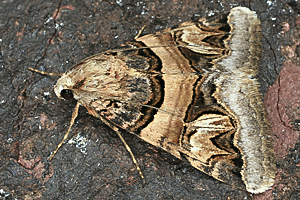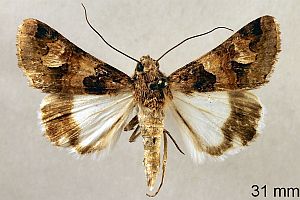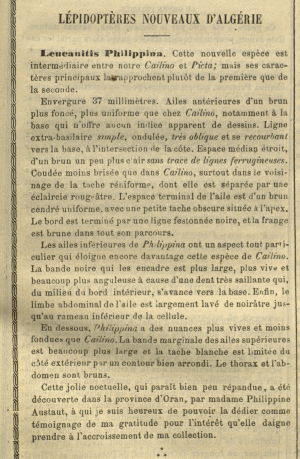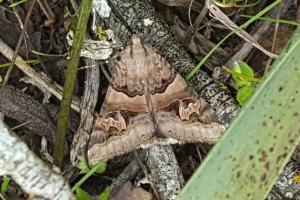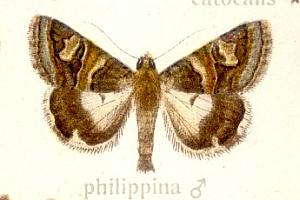

 +8Kontinente:EUASAF
+8Kontinente:EUASAF2. Diagnose
2.1. Männchen
2.2. Erstbeschreibung
4. Weitere Informationen
4.1. Andere Kombinationen
- Leucanitis philippina Austaut, 1880 [Originalkombination]
4.2. Autorenschaft
In der Fauna Europaea, last update 23 july 2012, version 2.5 [nicht mehr zugänglich] wurde der Autor zu "Austadt" verunstaltet.
4.3. Taxonomie
Matov & Korb (2019) bestätigen bei Drasteria cailino ausdrücklich: "The closely related species, D. philippina (Austaut, 1800), described with type locality “… dans la province d’Oran…” in Algeria, we do not review (it is out of the studied territory). However, two samples of it were mined from BOLD and used in our analysis (Fig. 327). The analysis clearly showed its species status because both samples occupied separate position with big distance on the phylogenetic tree."
4.4. Faunistik
Bis 2. April 2019 war hier zu lesen: "Eine Art der Kanaren, in Europa i.e.S. fehlend." Dann erschien der Artikel von Catania (2019) mit dem Titel: "Drasteria philippina (Austaut, 1880) a new record for the Maltese Islands and Europe". Wieder einmal waren es heftige Südwest-Winde, die den Falter von Nordafrika nach Malta trugen: 1 ♂ Żebbuġ, 21. März 2018, Lichtfang Aldo Catania. Das Tier wurde genitalüberprüft und die Determination zusätzlich von Laszlo Ronkay bestätigt. Catania (2019: 172-173) macht sich Gedanken: "The observation of Drasteria philippina (Austaut, 1880) in the Maltese islands is very remarkable. If this phenomenon is a cause of global warming one cannot be so sure, but it is a fact, that recently, records of Lepidoptera from the North African continent have constantly been recorded from the Maltese islands. Since a few years back the Desert Babul Blue Azanus ubaldus (Cramer, 1782) (Catania et al., 2017), Bocchoris bleusei (Oberthür, 1887) (Catania, 2017) and Isturgia disputaria (Guenée, 1858) (Catania, 2010) have been recorded as making their way to the Maltese Islands on windy days blowing from the South. Drasteria philippina was also recorded during a night with very strong winds blowing from the South West of the Maltese Islands." Und Catania (2019: 173) schreibt zur Gesamtverbreitung: "The distributional range of Drasteria philippina extends from Morocco throughout the African Mediterranean and the northern parts of the Sahara (Algeria, Libya, to Egypt, and the Israel’s Negev desert) (Austaut, 1880)."
(Autor: Erwin Rennwald)
4.5. Literatur
- Erstbeschreibung: Austaut, J.-L. (1880): Lépidoptères nouveaux d'Algérie. — Le Naturaliste 2 (30): 237.
- Catania, A. (2019): Drasteria philippina (Austaut, 1880) a new record for the Maltese Islands and Europe (Lepidoptera: Erebidae). — SHILAP Revista de lepidopterología 47 (185): 171-176. [PDF auf redalyc.org]
- Matov, A.Y. & S.K. Korb (2019): A revision of the genus Drasteria of Central Asia and Kazakhstan with special attention to the adjacent areas (Lepidoptera: Erebidae). — Zootaxa 4673 (1): 1–104. [https://doi.org/10.11646/zootaxa.4673.1.1]









